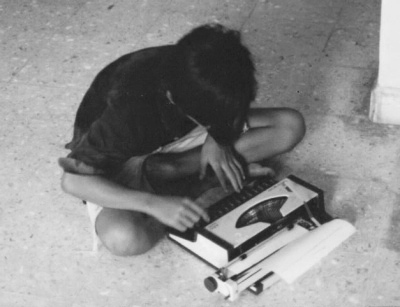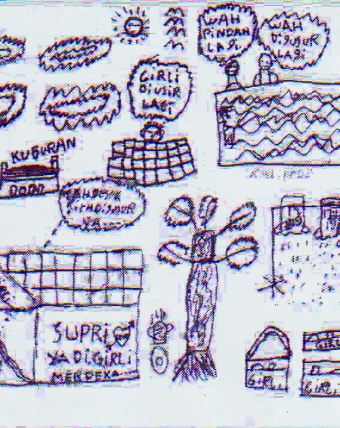Kirik Ertanto
Evicted againSupri |
The New Order had no place for poets like Rendra, and fearful that an artist could trigger change, the authorities jailed him in 1978. A poet cannot achieve change in the same way a revolution can. But he can indicate the direction in which his nation should travel.
As an adolescent in the 1980s, I enjoyed reading Rendra’s poems. His poetry exposed the tensions within the society of that time: freedom and oppression; justice and exploitation; good and evil. The poems felt so relevant. ‘Bersatulah Pelacur-pelacur Jakarta’ (Prostitutes of Jakarta Unite), for example, was a daring defence of women accused of immorality, whom, it argued, were completely exploited. It uncovered the real values of a hypocritical and unjust society rotting from deep within. Poems like this connected me deeply with my senses and ignited my imagination.
But Rendra’s poetry is not to be contemplated alone in solitude. It demands action. In my case, his poems, with their stimulating and critical wisdom, were one of the triggers for my involvement with the Keluarga Girli (Riverside Family) in the city of Yogyakarta.
A cry for justice
Defending the little people was what Rendra did. In ‘Sajak Sebotol Bir’ (A Poem for a Bottle of Beer) he wrote:
Hiburan kota besar dalam semalam
Sama dengan biaya pembangunan sepuluh desa!
Peradaban apakah yang kita pertahankan?
The night life of one city
Could fund the development of ten villages!
What sort of civilization are we sustaining?
Rendra’s poems voiced the claims of injustice during the New Order era. In the last stanza of the ‘Sajak Orang Kepanasan’ (Poem of The Inflamed) he fiercely proclaimed:
Karena kami arus kali
dan kamu batu tanpa hati
maka air akan mengikis batu
Because we are the river current
And you are the heartless rocks
the water will wear you away
Rendra’s poetry recognises that culture and social structure are things that humans create and that they themselves can change. His poetry was often political in nature and deeply critical of society’s faults. It inspired us in our work with the street kids of Yogyakarta and was reflected in the kids’ own creative activities.
A place to call home
In Yogyakarta in the 1980s, a small band of roughly 30 street kids began appearing around the Tugu railway station and the main street of Malioboro, forced onto the streets because they could no longer face their violent parents. Some, like Dodo, had been thrown out by their own mothers.
These vagrant children worked as shoe-shine boys, scavengers and beggars. Each morning they had a breakfast of nasi gudeg, a sweet concotion of stewed jackfruit and rice, at the foodstall of Mak Ndut near the eastern end of Tugu station. After that they would separate to earn money before meeting again at 7 pm at Mak Ndut’s. Before eating they would share stories of their day’s experiences. Afterwards they would do their own thing. Some would play thithikan (throwing coins then betting on the drawing or number); others would go to Ngebong to seek out sex workers or watch films at the Arjuna Theatre. At night they would compete for safe places to sleep away from street-clearing operations. Their beds were spread-out sheets of cardboard or newspapers scavenged earlier.
In 1986 the Catholic priest and well-known activist Romo Mangun offered the street kids a house at a nominal rent. The house stood on the bank of the Code River south of the Gondolayu bridge. They quickly developed a new habit, speaking affectionately of their home. The expression ‘going home’, used to farewell their friends when they wanted to sleep, signaled a significant change in this circle. They felt like family, living together in the one house. This feeling prompted one of them, named Mul, to suggest that they form a group, which they called the extended Girli family. The name was chosen to remember the place where they first lived in a house, namely at the pingGIR kaLI (Code RIverSIde).
After two years living at the Code River, the Girli extended family moved from one neighbourhood to another. Renting a house created its own problems. Some local complained that Girli’s presence made the neighbourhood unruly. At the beginning of the 1990s, they were evicted from their house in Juminahan for not having valid identity cards. These experiences were deeply disturbing to street kids so familiar with uncertainty.
In defence of street kids
It was clear that more was needed if the street kids were to gain any real sense of security. My friends and I from the Humana Social Studies Foundation were concerned because the state bureaucracy continued to threaten the street kids with eviction even though they were Indonesian citizens. So we developed two strategies. The first of these was to open a studio. The second was to raise support from among the Malioboro community, where they spent much of their time.
The studio was established to help them acquire knowledge to balance the pressures they faced. Activities included learning to read, write and draw. Through drawings and scribbles the street kids expressed their day-to-day feelings. As one street kid commented:
I used to shine shoes, now I’d be embarrassed to do so because it’s for young tekyan [the term the street kids used to describe themselves]. But what I make from selling handicrafts isn’t much. Shining shoes I could make three thousand five hundred. Selling I make at the most two thousand. You make more shining shoes. But I’d be too ashamed to shoe-shine. Don’t write my name ya. Don’t shame me.
From such scraps my friends and I started to get a sense of what we had to do. We began by seeking support from other groups to help meet the needs of the street kids, recruiting lecturers, uni students, artists, clergymen, doctors and people from the surrounding neighbourhood. Our activities broadened from writing and drawing to discussions, which were then printed in the magazine, JEJAL Malioboro (literally Street Cries from Malioboro). There were regular poetry columns, short stories and often disturbing tales of the lives and backgrounds of the street kids. We also organised skills training, alternative economic activities and health services for those with no access to a community health centre or hospital. These activities brought a wealth of new experiences and knowledge – and provided something of a safety net – to the Girli family.
 |
Tekyan true confessionsSlamet Sukeri |
In addition we tried to develop a sense of community amongst the people of Malioboro. The activities at the studio linked the street kids with the educated. But through the Malioboro community, we sought to develop an alliance with the petty criminals, pavement sellers, parking attendants, peddlers, ‘tough guys’and also the street artists of Malioboro. Relations among these groups were very fragile, at times peaceful and at others fraught. But by 1996-97 the atmosphere on Malioboro was no longer pleasant for its inhabitants. There were frequent inter-group conflicts, some involving the Girli kids. A street musician respected by many of the Malioboro inhabitants told me, ‘You can’t have a discussion anymore with Malioboro folk. Especially the young ones. You give them advice and they get angry. Every day there’s always someone fighting.’
Art as social critique
We had a range of discussions with Girli youths about how to stem the conflict. Eventually it was decided to use the celebration of the Girli anniversary usually held around February to stage a Malioboro Art Spontaneity event. This event also commemorated the deaths of Untung and Dodo, two members of the Girli family. Untung was killed by an insurance syndicate, his corpse swallowed by the Ambon Sea. Dodo died after an accidental stabbing in a fight between two gangs. The fact that he didn’t have an identity card almost prevented his burial. Both were well known by the Malioboro community and their deaths became a symbol for the oppressed.
Unlike previous events, the Street Art Spontaneity committee consisted of representatives of the various Malioboro groups. Preparations included discussions on how to bring the Malioboro community closer through art. One of the agreements reached was to form a Malioboro Street Art Community to hold routine events using art to bring the community together.
In the lead-up to the performance we frequently discussed the role of art. Over an evening glass of tea or lapen (locally-made alcohol) we would talk of the great writers who used to hang out in Malioboro. We spoke of Umbu, the president of Malioboro Poets, Emha Ainun Najib and his theatre of liberation, and of course Rendra and his poetry. Most of us embraced Rendra’s cultural vision of art as a part of social critique. Rendra’s poems had taught us that art cannot (and should not) be separated from its environment and the suffering of those around us, as it is meaningless and insignificant if it ignores society’s problems. For us the Malioboro Art Spontaneity performance was one manifestation of Rendra’s cultural vision, helping as it did to arouse cultural awareness and re-sensitise people to the misery in their surroundings.
The November 1998 event opened with a performance in front of the Hotel Garuda on Malioboro including a typical and fully authentic Javanese commemoration of the dead. At the end a parade carried photographs of Dodo and Untung down Malioboro to the Governor’s Office. Moving the ceremony from the house to the street demonstrated everything that had gone wrong until then: Dodo dying and not being able to be buried and Untung’s murder and the dumping of his body in the ocean. Poetry readings and music followed.
During the performance, Rendra arrived unexpectedly. Afterwards we had a small discussion with him about Malioboro. As a result of this discussion we began to see Malioboro not just as a physical place but also a place of imaginings and hope, where various groups met to find something new. The Malioboro art performance was the start of new ties and a search for a different identity. For me that evening’s meeting further strengthened the path the Malioboro Art Community had chosen.
The Malioboro Art Spontaneity Performance was a new experience. People from diverse parts of society – children, adults, men, women, Chinese, Javanese and other ethnic groups – all freely expressed their opinions and their voices were equally valued. It was not surprising that this led to the emergence of a new identity that helped dismantle the New Order compartmentalisation on the basis of residence, ethnic group, race and religion (known by the acronym of SARA suku agama ras). And so, at a time when the political parties, the mass media and social sciences were silenced by political repression, reading Rendra’s poetry made us think. And to think means to do.
Kirik Ertanto (asujegog@yahoo.com) is an anthropology graduate from the University of Gadjah Mada (fondly known by some of its graduates as Universitas Gelandangan Malioboro or Malioboro University Vagrants). He now works in child protection for Save the Children in Indonesia.
